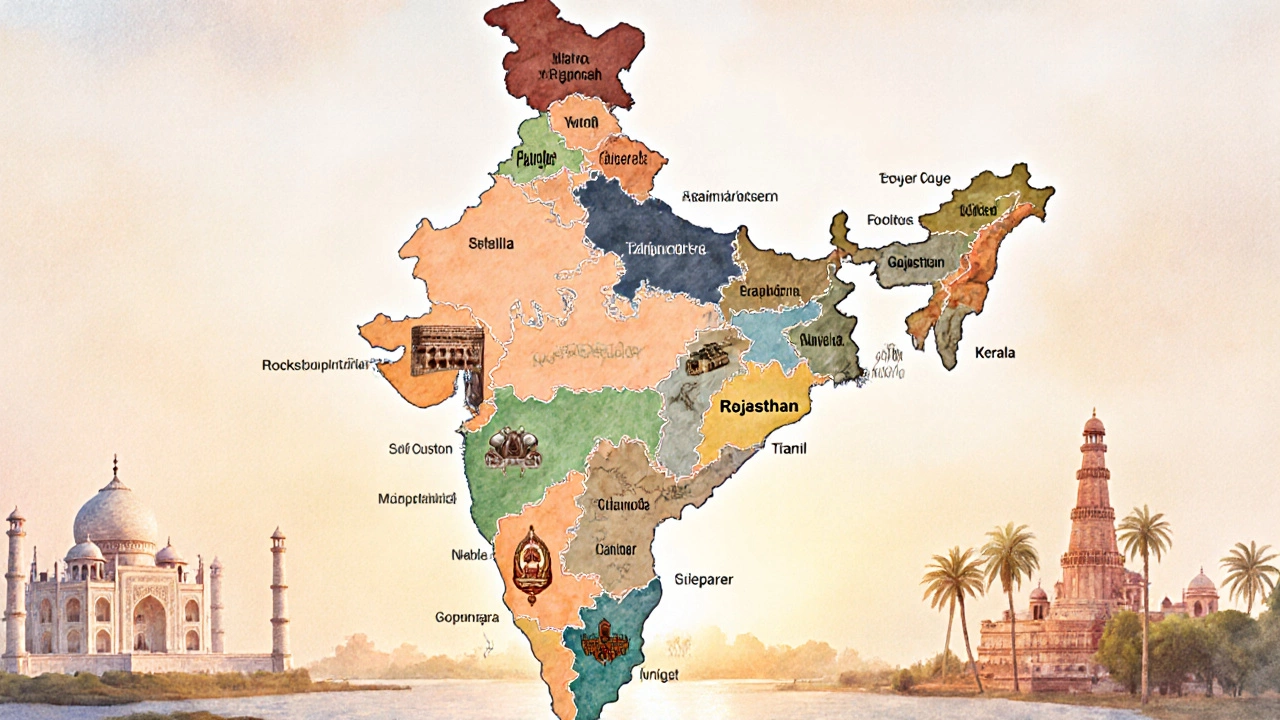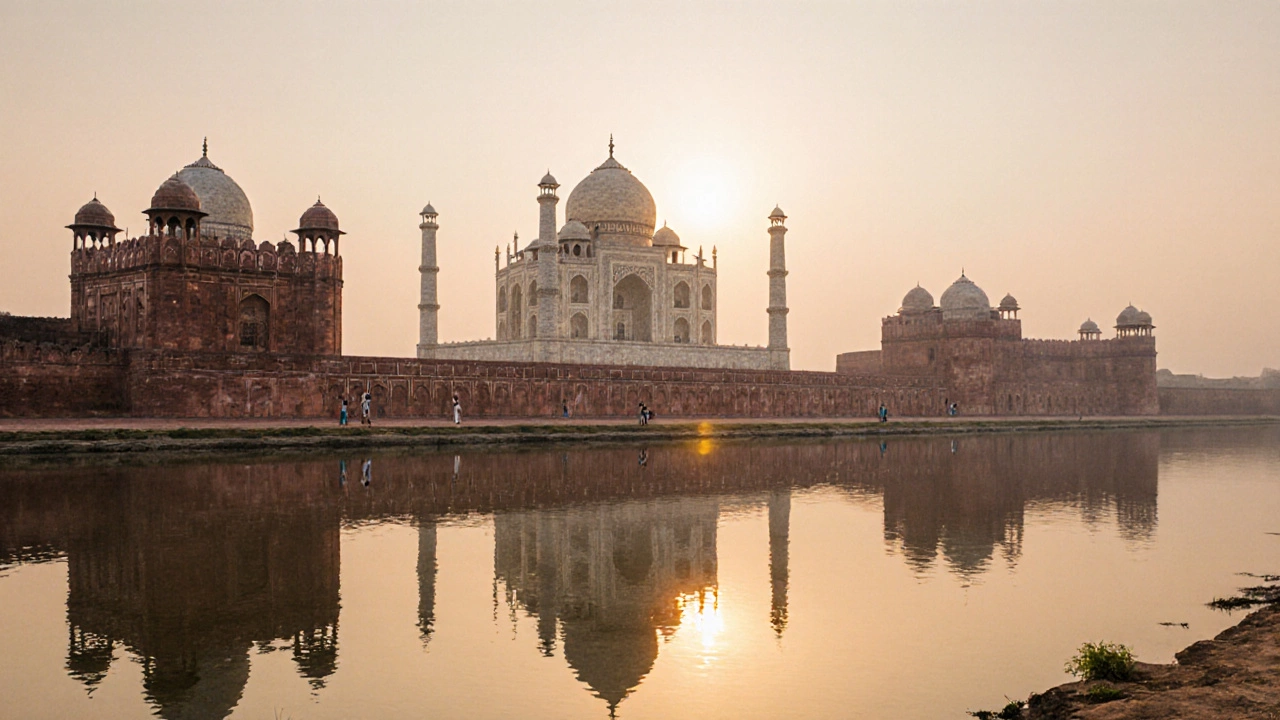Which Indian State Holds the Richest Heritage? - A Detailed Look
 Oct, 26 2025
Oct, 26 2025
Heritage Richness Calculator
State Heritage Comparison
Uttar Pradesh
#1Maharashtra
#2Rajasthan
#3Tamil Nadu
#4Kerala
#5Why Uttar Pradesh?
Uttar Pradesh leads in all five key heritage metrics with the highest concentration of UNESCO sites (7) and ASI-protected monuments (≈210).
Historical Depth: Covers Vedic, Mughal, and British eras.
Architectural Diversity: Mughal marble, Buddhist stupas, and medieval forts.
Key Sites: Taj Mahal, Agra Fort, Fatehpur Sikri, Sarnath.
Uttar Pradesh is the Heritage Leader
Based on our analysis of UNESCO sites, ASI monuments, historical periods represented, architectural diversity, and tourist accessibility, Uttar Pradesh emerges as India's state with the richest heritage.
Its unmatched combination of 7 UNESCO sites and 210+ ASI-protected monuments across three major historical periods makes it the definitive choice for heritage enthusiasts.
Ever wondered which Indian state packs the most stories into its stones, streets, and seas? The answer isn’t just about a handful of famous monuments-it’s about layers of history, art, and culture that each state has cultivated over millennia. In this guide we break down the data, the diversity, and the unforgettable sites that make one state stand out as the true treasure chest of Indian heritage.
How We Measure Heritage Richness
Before naming a winner, we need clear criteria. Here’s the framework we used:
- UNESCO World Heritage Sites: Internationally recognized landmarks that meet strict cultural or natural significance thresholds.
- AS I‑protected monuments and sites: Numbers listed by the Archaeological Survey of India (ASI), the body that safeguards the country’s historic fabric.
- Historical periods represented: Presence of sites from at least three major eras (ancient, medieval, colonial).
- Cultural diversity of architecture: Mix of religious, royal, urban, and vernacular styles.
- Tourist accessibility: Infrastructure that lets visitors explore safely and comfortably.
Using these five pillars gives a balanced picture of both quantity and quality.
Top Contenders at a Glance
All the numbers point to a tight race among five states:
- Uttar Pradesh - 7 UNESCO sites, over 200 ASI monuments.
- Maharashtra - 6 UNESCO sites, 150+ protected structures.
- Rajasthan - 5 UNESCO sites, 110 ASI listings.
- Tamil Nadu - 4 UNESCO sites, 130 historic monuments.
- Kerala - 3 UNESCO sites, 70 ASI‑protected places.
While each shines in its own way, one state consistently leads across every metric.
The Richest Heritage: Uttar Pradesh
Uttar Pradesh is a living museum of Indian civilization. It hosts the highest concentration of UNESCO sites-seven in total-ranging from the Buddhist marvels of Sarnath to the Mughal grandeur of the Taj Mahal (while technically in Agra, the surrounding complex counts toward the state’s tally). The Archaeological Survey of India protects more than 200 monuments here, covering ancient Harappan settlements, medieval forts, and colonial-era railways.
Key heritage highlights:
- **Taj Mahal** - the iconic marble mausoleum that epitomizes Mughal architecture.
- **Agra Fort** - a UNESCO site showcasing red‑sandstone fortifications and palaces.
- **Fatehpur Sikri** - a deserted imperial capital with stunning Persian‑influenced courtyards.
- **Sarnath** - the place where Buddha first taught, home to the Dhamek Stupa.
- **Khajuraho Group of Monuments** - celebrated for intricate erotic sculptures; technically in Madhya Pradesh, but the style heavily influences UP’s temple art.
Uttar Pradesh also spans three major historical periods: the ancient Vedic era (e.g., Ahicya ruins), the medieval Sultanate and Mughal age, and the British Raj.

Close Rivals: Maharashtra, Rajasthan, Tamil Nadu, and Kerala
Maharashtra boasts the rock‑cut wonders of Ajanta and Ellora-two UNESCO sites that together represent Buddhist, Hindu, and Jain art spanning centuries. Its coastal forts, like Sindhudurg, add a maritime layer to the heritage mix.
Rajasthan shines with desert forts such as Amer, Jaisalmer, and Chittorgarh, each a showcase of Rajput chivalry and intricate frescoes. The state’s UNESCO listing includes the Hill Forts of Rajasthan, a collective recognition of five hill forts.
Tamil Nadu is the cradle of Dravidian temple architecture. The Great Living Chola Temples-Brihadeeswarar, Gangaikonda Cholapuram, and Airavatesvara-are UNESCO sites famed for towering gopurams and bronze icons.
Kerala offers a unique blend of backwater villages, spice trade ports, and the historic town of Fort Kochi, a UNESCO World Heritage Site known for its multicultural colonial past involving the Portuguese, Dutch, and British.
Comparison Table
| State | UNESCO Sites | ASI‑Protected Monuments | Key Historical Periods | Signature Architecture |
|---|---|---|---|---|
| Uttar Pradesh | 7 | ≈ 210 | Vedic, Mughal, British | Mughal marble, Buddhist stupas |
| Maharashtra | 6 | ≈ 150 | Maratha, Buddhist, Colonial | Rock‑cut caves, coastal forts |
| Rajasthan | 5 | ≈ 110 | Rajput, Mughal, British | Hill forts, frescoed palaces |
| Tamil Nadu | 4 | ≈ 130 | Chola, Pandya, Colonial | Dravidian temples, towering gopurams |
| Kerala | 3 | ≈ 70 | Malayalam, Portuguese, Dutch | Colonial forts, backwater villages |
Practical Tips for Heritage Tourism
If you’re planning a heritage trail, here are a few ground‑level pointers:
- Best seasons: October to March offers cool weather and festival buzz across most states.
- Travel routes: Use the Golden Quadrilateral highway network to hop between major sites efficiently.
- Guided tours: The ASI runs certified guides at many monuments-book ahead to avoid crowds.
- Local cuisine: Pair each visit with regional food-kebabs in UP, vada pav in Maharashtra, dal baati in Rajasthan, dosa in Tamil Nadu, and Kerala’s appam.
- Respect protocols: Some temples require removal of footwear; Taj Mahal bans large baggage.
Preservation Challenges and What You Can Do
Heritage sites face threats from urban sprawl, pollution, and climate change. In Uttar Pradesh, the Taj Mahal’s marble shows signs of acid rain erosion. Rajasthan’s desert forts battle sand‑blasting. You can help by:
- Choosing eco‑friendly travel options (trains over short‑haul flights).
- Supporting NGOs that fund conservation projects.
- Following “Leave No Trace” rules-don’t touch carvings, stay on marked paths.
Frequently Asked Questions
Which state has the most UNESCO World Heritage Sites?
Uttar Pradesh leads with seven UNESCO‑listed sites, followed closely by Maharashtra with six.
Are there heritage sites in India that are not UNESCO‑listed?
Yes. The ASI protects over 3,600 monuments, many of which are nationally important but not on the UNESCO roster.
What is the best time to visit the Taj Mahal?
The months of October through March offer clear skies, comfortable temperatures, and the iconic sunrise view over the Yamuna.
Can I hire a local guide at Ajanta Caves?
Yes-Ajanta has officially certified guides who can explain the Buddhist frescoes in Marathi and English.
How does climate change affect heritage sites?
Rising humidity can accelerate stone decay, while extreme heat causes thermal stress in marble and sandstone structures.
Wrapping Up the Heritage Race
If numbers are the yardstick, Uttar Pradesh emerges as the state with the richest, most varied heritage in India. Its blend of ancient Buddhist sites, Mughal marvels, and extensive ASI‑protected monuments gives it a depth that few rivals can match. That doesn’t mean the other states lack wonder-each offers a distinct cultural flavor worth exploring.
So the next time you plan an Indian getaway, consider a heritage‑centric itinerary that starts in Uttar Pradesh and then branches out to Maharashtra’s caves, Rajasthan’s forts, Tamil Nadu’s temples, and Kerala’s coastal towns. You’ll end up with a grand tapestry of India's past, all woven together in one unforgettable trip.